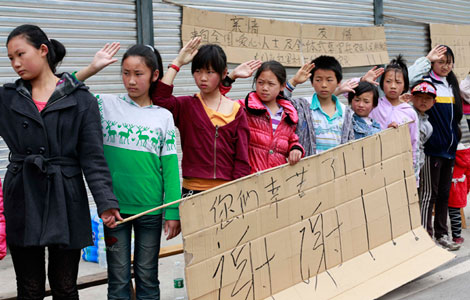China slowdown means 'healthier growth'
Updated: 2012-04-14 09:23
(Xinhua)
|
||||||||
BEIJING - All eyes were on China Friday, when the world's second-largest economy released its gross domestic product (GDP) figures for the first quarter.
China's GDP reached 10.7995 trillion yuan ($1.72 trillion) in the first three months of this year, up 8.1 percent year-on-year, marking the slowest quarterly expansion since the second quarter of 2009, according to the National Bureau of Statistics (NBS).
The lower-than-expected GDP data decelerated further from 8.9 percent in the fourth quarter of 2011, sending temporary shock waves to equity and commodity markets at home and abroad.
Should the world be scared at China's disappointing GDP figure? Of course not.
To get a broader picture of the complexity of China's economy, it's necessary to scrutinize more indicators than just the GDP figures available this week.
Exports beat expectations, so did new lending in March. The Purchasing Managers Index (PMI) that measures manufacturing activity rose unexpectedly too, for four consecutive months to the highest level in a year.
Moreover, two other indexes on personal income nurtured hope for a more sustainable growth for the world's second-largest economy in the future, in the exact direction policymakers are trying to steer the country's development.
In the first quarter, the per capita income of urban and rural residents rose in real terms, 9.8 percent and 12.7 percent, respectively, both outpacing GDP growth, according to the NBS.
If this trend continues, we're more likely to see a consumption-driven China with its 1.3 billion consumers taking shape now than any time in the past. Over the past three decades, per capita income rarely grew faster than the general economy.
Therefore the latest changes in China's growth story will eventually create greater potential for domestic demand and bodes well for goods and service providers at home and abroad.
In the midst of a weak global recovery, China continues to be the global growth leader, compared with heavily indebted advanced economies.
According to BlackRock, a global investment and fund managing company, China will contribute to two-fifths of global growth this year, twice as much as the United States.
Potentially, China can still stimulate its economic growth much faster than 8.1 percent with enough firepower within its policy ammunition, if the slowdown falls near the targeted 7.5-percent level.
The country once adopted a 4-trillion-yuan package of stimulus measures to spur the economy in 2009 when the world was deeply entrenched in the global financial meltdown.
However, the problems of a slowing China should not be overemphasized as the nation is now undergoing a structural shift from resources- and investment-driven growth to a more balanced and more sustainable pattern through innovation and rebalancing of the economy.
The Chinese government has the ability and efficiency to act quickly to stabilize short-term growth, but any deja vu of massive stimulus the size of 2009 stimulus should take into account the impact of inflation and rising assets bubble on the well-being of ordinary people, particularly those underprivileged groups.
If China draws on this global economic cycle to complete its historic mission to transform into a balanced and sustainable economy, the slowdown in the first quarter may prove to be only the growing pains for a much healthier growth for the world's second-largest economy in the long run.

 Relief reaches isolated village
Relief reaches isolated village
 Rainfall poses new threats to quake-hit region
Rainfall poses new threats to quake-hit region
 Funerals begin for Boston bombing victims
Funerals begin for Boston bombing victims
 Quake takeaway from China's Air Force
Quake takeaway from China's Air Force
 Obama celebrates young inventors at science fair
Obama celebrates young inventors at science fair
 Earth Day marked around the world
Earth Day marked around the world
 Volunteer team helping students find sense of normalcy
Volunteer team helping students find sense of normalcy
 Ethnic groups quick to join rescue efforts
Ethnic groups quick to join rescue efforts
Most Viewed
Editor's Picks

|

|

|

|

|

|
Today's Top News
Health new priority for quake zone
Xi meets US top military officer
Japan's boats driven out of Diaoyu
China mulls online shopping legislation
Bird flu death toll rises to 22
Putin appoints new ambassador to China
Japanese ships blocked from Diaoyu Islands
Inspired by Guan, more Chinese pick up golf
US Weekly

|

|







